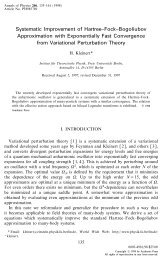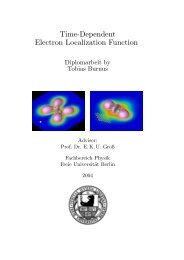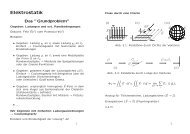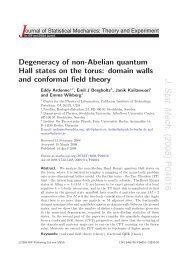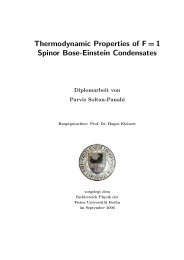Einstein's 1905 paper
Einstein's 1905 paper
Einstein's 1905 paper
Create successful ePaper yourself
Turn your PDF publications into a flip-book with our unique Google optimized e-Paper software.
η, ζ τ, determining that event relatively to the system k, and our task is now<br />
to find the system of equations connecting these quantities.<br />
In the first place it is clear that the equations must be linear on account of<br />
the properties of homogeneity which we attribute to space and time.<br />
If we place x ′ = x − vt, it is clear that a point at rest in the system k must<br />
have a system of values x ′ , y, z, independent of time. We first define τ as a<br />
function of x ′ , y, z, and t. To do this we have to express in equations that τ is<br />
nothing else than the summary of the data of clocks at rest in system k, which<br />
have been synchronized according to the rule given in § 1.<br />
From the origin of system k let a ray be emitted at the time τ 0 along the<br />
X-axis to x ′ , and at the time τ 1 be reflected thence to the origin of the coordinates,<br />
arriving there at the time τ 2 ; we then must have 1 2 (τ 0 + τ 2 ) = τ 1 , or,<br />
by inserting the arguments of the function τ and applying the principle of the<br />
constancy of the velocity of light in the stationary system:—<br />
1<br />
2<br />
[<br />
τ(0, 0, 0, t) + τ<br />
(0, 0, 0, t + x′<br />
c − v + x′<br />
c + v<br />
)]<br />
= τ<br />
Hence, if x ′ be chosen infinitesimally small,<br />
(<br />
1 1<br />
2 c − v + 1 ) ∂τ<br />
c + v ∂t = ∂τ<br />
∂x ′ + 1 ∂τ<br />
c − v ∂t ,<br />
or<br />
∂τ<br />
∂x ′ + v ∂τ<br />
c 2 − v 2 ∂t = 0.<br />
(x ′ , 0, 0, t + x′<br />
c − v<br />
It is to be noted that instead of the origin of the co-ordinates we might have<br />
chosen any other point for the point of origin of the ray, and the equation just<br />
obtained is therefore valid for all values of x ′ , y, z.<br />
An analogous consideration—applied to the axes of Y and Z—it being borne<br />
in mind that light is always propagated along these axes, when viewed from the<br />
stationary system, with the velocity √ c 2 − v 2 gives us<br />
∂τ ∂τ<br />
= 0,<br />
∂y ∂z = 0.<br />
Since τ is a linear function, it follows from these equations that<br />
(<br />
)<br />
v<br />
τ = a t −<br />
c 2 − v 2 x′<br />
where a is a function φ(v) at present unknown, and where for brevity it is<br />
assumed that at the origin of k, τ = 0, when t = 0.<br />
With the help of this result we easily determine the quantities ξ, η, ζ by<br />
expressing in equations that light (as required by the principle of the constancy<br />
of the velocity of light, in combination with the principle of relativity) is also<br />
)<br />
.<br />
6




